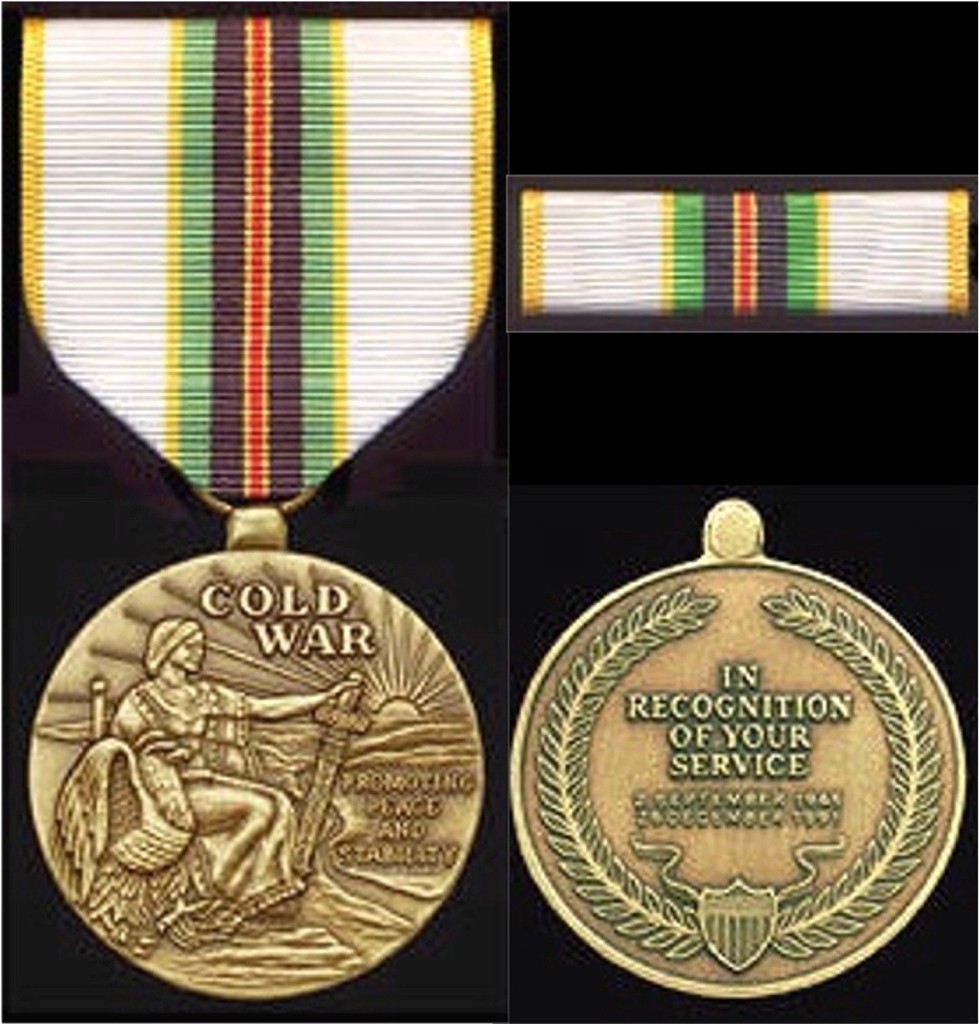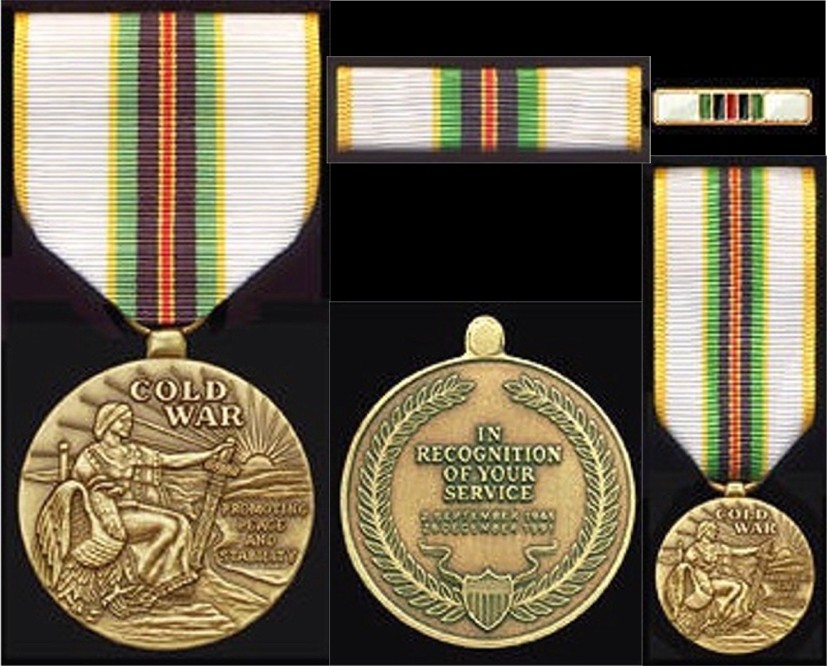
TO PURCHASE THE COLD WAR MEDAL
TO OBTAIN THE COLD WAR RECOGNITION CERTIFICATE
BACKGROUND INFORMATION ON THE COLD WAR MEDAL
THE COLD WAR VETERANS' ASSOCIATION
 $24.95 |
 $30.95 |
Photos by Vic Damon
(3rd Armored Division Cold War Veteran)
ooo000ooo
P.O. Box 710
Madison,Virginia 22727
HOW TO OBTAIN YOUR COLD WAR RECOGNITION CERTIFICATE
The Cold War medal was inspired by the Cold War Recognition Certificate created by Section 1084 of Public Law 105-85, approved on November 18, 1987 (The "National Defense Authorization Act for Fiscal year 1998"). This certificate recognizes "members of the Armed Forces and civilian personnel of the Government who served the United States during the Cold War."
How to Apply for the Cold War Recognition Certificate
All eligible personnel must apply for the certificate on their own behalf. The Department of the Army is the Executive Agent for processing all applications. Send your request by mail to:
Cold War Recognition Program
ATTN: AHRC-PDP-A, Department 480
1600 Spearhead Division Avenue
Fort Knox, KY 40122-5408
If you are no longer on active duty, your best bet is to obtain application procedures directly from the Army and then FAX them a copy of your DD-214 (Certificate of Release/Discharge from Active Duty). Please bear in mind that demand for the certificates has been heavy, and it may take a month or more for your application to be processed.
BACKGROUND INFORMATION ON THE COLD WAR MEDAL
Congress did not specifically authorize a medal for Federal service during the cold war, but limited its official recognition to the Cold War Recognition Certificate. This medal is intended for use by State Guard organizations, military and patriotic societies, and by private citizens who served during the Cold War. It has been adopted as an official medal of the Military Order of Foreign Wars. It offers a unique form of recognition specifically for citizen-soldiers and Federal civilian employees who served during the cold war. Interest in this medal has been strong, and many former service members have obtained it to place in a shadow box with their Federal and State military awards.
Period of Service
The medal recognizes honorable service between the inclusive dates of September 2, 1945 and December 26, 1991.
Designer
The Cold War Medal was designed by Nadine Russell, the Chief of Creative Heraldry at the Army's Institute of Heraldry and the designer of many campaign and service medals, including the Southwest Asia Service Medal, the Armed Forces Service Medal, and the Outstanding Military Volunteer Service Medal.
Symbolism
Obverse
The allegorical figure of Freedom sits upon a vantage point over-looking a landscape suggestive of the Fulda Gap, the anticipated point of attack by Communist forces in Europe during the Cold War. The Fulda Gap thus represents all territory subject to the threat of invasion or war. The sitting figure also alludes to a long-term and watchful military presence. She holds a sheathed Roman sword in her hand, point down. The sword represents military strength, and its being sheathed is symbolic of defensive military action. Her foot rests on a book, representing both history and law. To her right is an American bald eagle grasping a bundle of arrows and an olive branch. The eagle, symbolic of the United States, represents the principles of freedom. The arrows stand for the willingness to use force in support of freedom, and the olive branch alludes to the goal of peace. Behind the figure of Freedom, and on the horizon of the landscape in front of her, a sun rising in the east symbolizes the birth of a new era of peace and stability arising from the end of the Cold War. Superimposed over the geographic scene, and below the rising sun, is the inscription, Promoting Peace and Stability, which is taken from the wording on the Congressional certificate and which identifies the efforts recognized by the medal.
Reverse
In the center of the medal, the inscription, IN RECOGNITION OF YOUR SERVICE, is enclosed within a stylized wreath of laurel, which represents honor. The wreath is tied at its base by a ribbon, the ends of which rise above a shield taken from the coat of arms of the United States. The dates 2 September 1945 - 26 December 1991, which are taken from the Congressional certificate, appear beneath the inscription.
Ribbon
In the center of the ribbon there is a narrow stripe of red, repre-senting courage and the willingness to sacrifice life for freedom. This red stripe is bordered by a narrow stripe of gold, which alludes to honor and achievement. The gold is bordered by black, which stands for the threat of war, and the black is bordered by green, which represents growth, hope, and life. The green is edged in gold, which is bordered by white, the predominant color of the ribbon and which represents integrity and purity of purpose. The ribbon is edged in gold.
Criteria
This medal may be worn by any individual for service in a component of the Armed Forces (including National Guard, State Guard, and Reserve Forces) and by civilian employees of the Government who contributed to the historic victory in the Cold War for any period between the inclusive dates of September 2, 1945 and December 26, 1991.
Background
The Yalta conference was a wartime planning session among the Allies held on February 4-11, 1945. Its purpose was to re-establish the nations that had been conquered by Germany and to reach an agreement on the occupation of Germany following the war. The United States and Great Britain made significant postwar territorial concessions to the Soviet Union, little realizing that after the War the Soviet Union would seek to extend its influence and control through-out Eastern Europe. However, following the war cooperation with our former ally collapsed as the Soviet Union extended its power and influence over Albania, Bulgaria, Estonia, Hungary, Latvia, Lithuania, Outer Mongolia, parts of Manchuria and North Korea, Romania, and Yugoslavia. They also annexed the Kurile Islands and the southern half of Sakhalin Island and fomented trouble in Iran, Turkey, and Greece. Not only did the Soviets dominate Eastern Europe, it became clear that they had designs on Western Europe as well.
On March 5, 1946, Winston Churchill delivered his famous speech at Westminster College in Fulton, Missouri, where he said, "It is my duty to place before you certain facts about the present position in Europe. From Stettin in the Baltic to Trieste in the Adriatic, an iron curtain has descended across the Continent. Behind that line lie all the capitals of the ancient states of Central and Eastern Europe." He went on to note that "Twice the United States has had to send several millions of its young men across the Atlantic to find the war; but now war can find any nation, wherever it may dwell between dusk and dawn."
On June 24, 1948 the Soviets imposed a blockade on Berlin. In order to avoid having to confront them directly, the United States initiated a massive airlift to provide the necessities of life to the 2.5 million residents of the city. In April of 1949 the North Atlantic Treaty Organization (NATO) was established, and on May 12, 1949, the blockade ended. However, there was little time for celebration: in September of 1949 the United States learned that the Soviets had the atomic bomb, and the cold war escalated dramatically in its intensity.
The Soviet efforts were countered by the so-called "Truman Doctrine." President Truman took the position that, "It must be the policy of the United States to support free peoples who are resisting attempted subjugation by armed minorities or by outside pressures." This policy ushered in an era of American efforts to halt Russian expansion. George F. Kennan, a diplomat and scholar, advocated a policy of "long-term, patient but firm and vigilant containment" based on the application of counterforce to the Soviet's expansionist efforts. This "containment policy" called for United States support in resisting Communist aggression throughout the world.
During the Cold War 325 Americans died as a result of hostile action; More than 200 airmen were killed by Communist air defenses, and more than 40 American intelligence aircraft were shot down, killing 64 Cryptologists and 40 crew members. Countless other Americans had their lives disrupted through military service in support of the Cold War. The Cold War was punctuated by such crises as the Berlin Airlift, the Cuban Missile Crisis and the Berlin Wall, each of which brought the world to the brink of disaster. The tide turned on November 9, 1989, when it became officially legal for people to come and go as they pleased into West Berlin; the next day they began to tear the wall down. Finally, on Christmas day in 1991, the Soviet Union collapsed and the cold war ended. Through the dedication and persistence of an entire generation of Americans and their allies, a catastrophic nuclear war with the Soviet Union was averted, and principles of democracy ultimately began to take root in Eastern Europe. The Cold War medal celebrates this epoch, which will ultimately be regarded as one of the great events of the Twentieth Century.
The Cold War Veterans Association fights for the rights of Cold War Veterans; provides education on why the Cold War was fought and won (and why vigilance must be maintained); and provides a fraternal community for men and women whose patriotism binds them together. To access their web site click here.